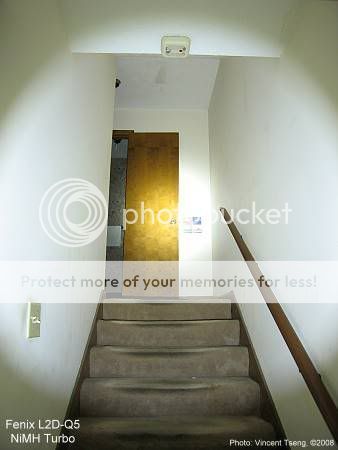Hot from the Fenix-Store -
the much talked about Fenix TK10
Packaging & label details -


Big sized box.
Size and head -


More compact than the T1 - with a removable "tactical grip ring", and more important for some a removable pocket clip.
There is a copper (colored) ring to replace the tactical grip ring so that threads are not exposed. Other spare parts are an orange tail cap, wrist strap, spare O-rings and a pair of spare screws for the clip as well as the corresponding allen key - these are all thoughtful touches - that seems to be a really welcome trait of Fenix.
OK, ok how does it perform?
Well if you were impressed with the Fenix T1 - then it's pretty fair to say you'll be just as impressed with the TK10.
vs. Fenix T1 both using primary CR123A and on High/Max
(I labelled it as "Turbo" in the beamshots, just so there is no doubt I am using the max brightness levels)


Not surprisingly they are about the same, the TK10 seems to have a slightly better tint - but this is merely samples of one - and open to the typical tint lottery. Of no real practical consequence is the characteristic Cree dark halo - otherwise the beam is smooth thanks to the orange-peel reflector.
vs. Fenix P3D-RB100 both on primary CR123A and Turbo/Max


the TK10 is brighter - but the Rebel100 has a smoother wider beam, and nicer tint.
vs. Fenix L2D-Q5 NiMH and Turbo


again the TK10 is obviously brighter in comparison both in the brighter side-spill as well as a tighter more concentrated hotspot - due to the larger head and reflector.
vs. L1D-Q5 BUT on 3.7V Rechargeable Li-Ion 14500 - Turbo


I still think the TK10 is a bit brighter along with the same comments as the L2D-Q5 comparison.
Impressive light - looks and feels tough - feels better in my hand - even though the tactical grip ring might seem "gimmicky" - it worked well for momentary on.
I feel that Fenix probably listened carefully to the critques on the T1, and tried to produce the TK10 more in-line with the feedback.
I like that thought.
the much talked about Fenix TK10
Packaging & label details -


Big sized box.
Size and head -


More compact than the T1 - with a removable "tactical grip ring", and more important for some a removable pocket clip.
There is a copper (colored) ring to replace the tactical grip ring so that threads are not exposed. Other spare parts are an orange tail cap, wrist strap, spare O-rings and a pair of spare screws for the clip as well as the corresponding allen key - these are all thoughtful touches - that seems to be a really welcome trait of Fenix.
OK, ok how does it perform?
Well if you were impressed with the Fenix T1 - then it's pretty fair to say you'll be just as impressed with the TK10.
vs. Fenix T1 both using primary CR123A and on High/Max
(I labelled it as "Turbo" in the beamshots, just so there is no doubt I am using the max brightness levels)


Not surprisingly they are about the same, the TK10 seems to have a slightly better tint - but this is merely samples of one - and open to the typical tint lottery. Of no real practical consequence is the characteristic Cree dark halo - otherwise the beam is smooth thanks to the orange-peel reflector.
vs. Fenix P3D-RB100 both on primary CR123A and Turbo/Max


the TK10 is brighter - but the Rebel100 has a smoother wider beam, and nicer tint.
vs. Fenix L2D-Q5 NiMH and Turbo


again the TK10 is obviously brighter in comparison both in the brighter side-spill as well as a tighter more concentrated hotspot - due to the larger head and reflector.
vs. L1D-Q5 BUT on 3.7V Rechargeable Li-Ion 14500 - Turbo


I still think the TK10 is a bit brighter along with the same comments as the L2D-Q5 comparison.
Impressive light - looks and feels tough - feels better in my hand - even though the tactical grip ring might seem "gimmicky" - it worked well for momentary on.
I feel that Fenix probably listened carefully to the critques on the T1, and tried to produce the TK10 more in-line with the feedback.
I like that thought.



















